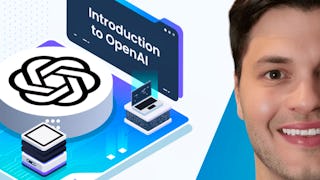Dive deep into DeepSeek’s architecture, core capabilities, and real-world applications with this advanced deepseek course designed for developers and AI professionals. You’ll explore the foundational DeepSeek AI models, groundbreaking innovations like Efficient Mixture of Experts (MoE) and Multi-Head Latent Attention (MLA), and gain hands-on experience with practical integration via API and local deployment.

Discover new skills with 30% off courses from industry experts. Save now.


Recommended experience
What you'll learn
Understand DeepSeek’s architecture, training strategies, and key innovations for scalable AI solutions.
Deploy and integrate DeepSeek AI models through APIs and local hosting for real-world applications.
Build and fine-tune DeepSeek models for advanced reasoning, text generation, and intelligent automation.
Apply DeepSeek in diverse domains, from workflow automation to RAG systems and custom AI-powered apps.
Skills you'll gain
Details to know

Add to your LinkedIn profile
May 2025
15 assignments
See how employees at top companies are mastering in-demand skills

There are 5 modules in this course
This module lays the groundwork for understanding DeepSeek’s capabilities, technical innovations, and practical access methods. It starts by introducing the strategic importance of DeepSeek in the broader AI landscape and provides a comparative look at its core models like V3, R1, and Janus Pro. Learners will gain a deeper appreciation for what sets DeepSeek apart in terms of performance, transparency, and cost-effectiveness. The module also walks through access methods—including web, local, API, and third-party interfaces—and addresses widespread myths related to DeepSeek’s origin, development cost, and security concerns. By the end, learners will have a clear understanding of how to access, evaluate, and use DeepSeek effectively and responsibly.
What's included
13 videos3 readings3 assignments1 discussion prompt
This module dives deep into the architectural design and technical innovations that define DeepSeek. It begins by explaining the high-level architecture of DeepSeek models and highlights their unique reasoning-centric training methodology, including the use of Reinforcement Learning from Human Feedback (RLHF). Learners will explore how DeepSeek models evolve from R1 to R1-Zero and understand the role of components like Multi-Head Latent Attention (MLA) and Mixture of Experts (MoE). By the end of this module, learners will have gained insight into how these innovations contribute to enhanced performance, scalability, and contextual understanding in AI outputs.
What's included
10 videos2 readings3 assignments
This module focuses on giving learners hands-on skills to deploy and integrate DeepSeek in both cloud and local environments. Learners will explore how to work with the DeepSeek API—from generating keys to integrating with automation tools such as N8N and Make.com. The second half of the module guides learners through self-hosting DeepSeek using tools like LMStudio, with step-by-step instructions on building local RAG (Retrieval-Augmented Generation) systems. Practical demonstrations ensure that learners can independently set up, manage, and troubleshoot deployments for varied use cases.
What's included
11 videos2 readings3 assignments
This module highlights the wide-ranging real-world use cases where DeepSeek excels. It starts by categorizing the types of tasks DeepSeek can handle—from simple content generation and classification to advanced problem-solving and reasoning. Learners will then explore how DeepSeek supports downstream tasks using embeddings and powers applications like Retrieval-Augmented Generation (RAG) and AI agents. The module wraps up with workflow automation, web/mobile app integration, and best practices for aligning DeepSeek with business or technical objectives.
What's included
11 videos2 readings3 assignments
This final module focuses on empowering developers with tools and techniques to enhance, adapt, and customize DeepSeek for specific software development needs. Learners will explore how to use DeepSeek for intelligent code generation, debugging, and test creation. The module also provides an end-to-end guide to fine-tuning DeepSeek models on custom datasets for specialized applications. By the end, learners will have both the foundational understanding and the practical skills to extend DeepSeek’s capabilities through customization and development-centric workflows.
What's included
10 videos2 readings3 assignments
Earn a career certificate
Add this credential to your LinkedIn profile, resume, or CV. Share it on social media and in your performance review.
Instructors


Offered by
Explore more from Machine Learning
 Status: Free Trial
Status: Free Trial Status: Preview
Status: PreviewCoursera Instructor Network
 Status: Free Trial
Status: Free Trial Status: Preview
Status: PreviewKodeKloud
Why people choose Coursera for their career





Open new doors with Coursera Plus
Unlimited access to 10,000+ world-class courses, hands-on projects, and job-ready certificate programs - all included in your subscription
Advance your career with an online degree
Earn a degree from world-class universities - 100% online
Join over 3,400 global companies that choose Coursera for Business
Upskill your employees to excel in the digital economy
Frequently asked questions
This course offers a deep dive into DeepSeek’s architecture, training methods, and real-world applications. You’ll gain hands-on experience with API integration, local deployment, workflow automation, and advanced fine-tuning techniques.
It’s ideal for AI developers, software engineers, data scientists, product managers, and automation architects who want to apply DeepSeek to scalable, AI-powered solutions.
Yes. If you're new to DeepSeek, start with DeepSeek Essentials: From Foundations to Real-World Use. It covers core concepts and basic integrations before you move on to this advanced course for deeper technical mastery.
More questions
Financial aid available,


